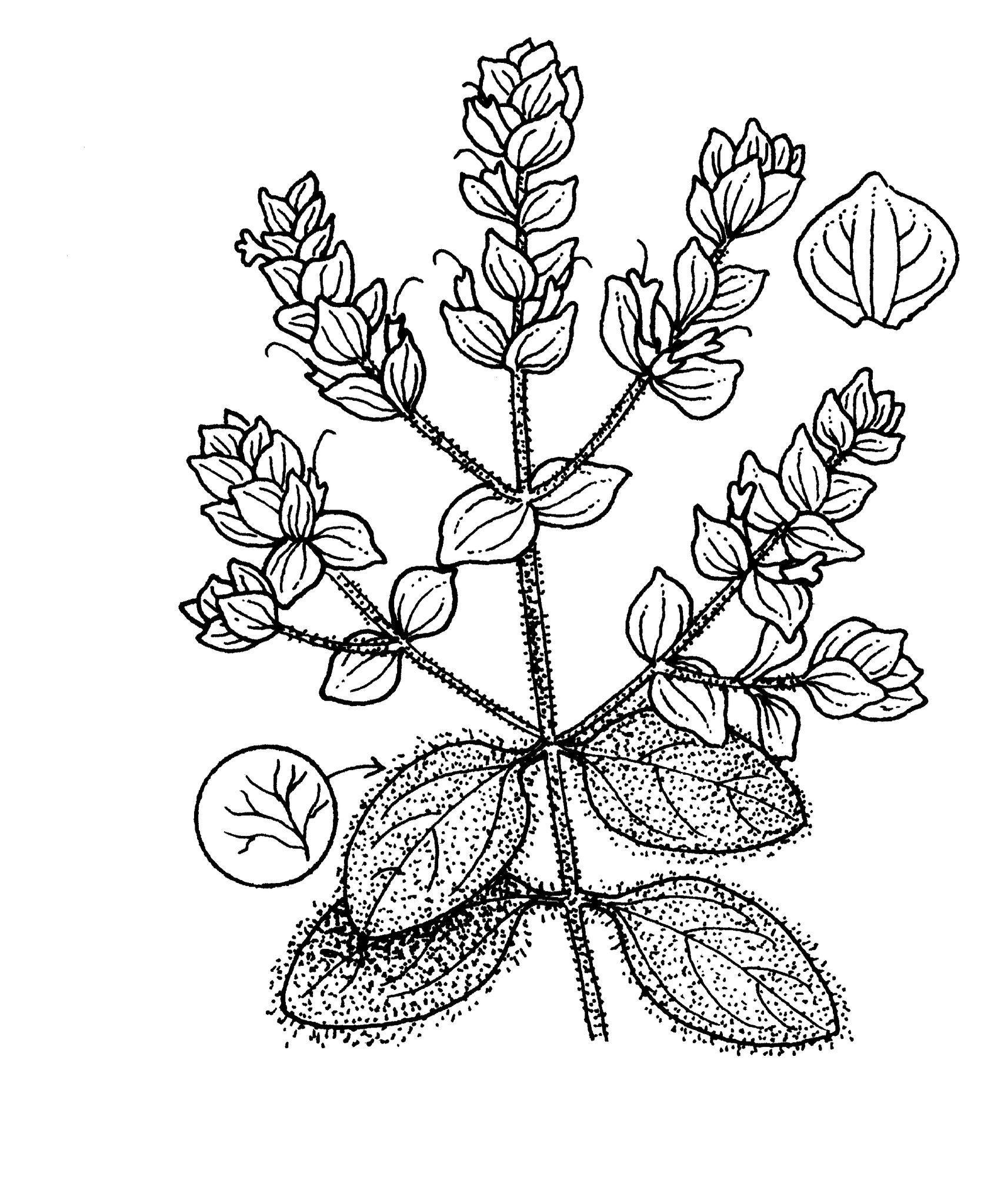
Latin — Origanum, Greek — Origanon, possibly from oros — mountain and ganos — delight.
Erect, spreading or prostrate aromatic subshrubs or woody perennial herbs. Leaves simple, heart-shaped, ovate or elliptic, entire or slightly toothed. Flower clusters much-branched panicles composed of short spikes of flowers subtended by often conspicuous, overlapping bracts, which are distinct from the leaves in shape, size and often colour and texture. Flowers variable. Calyx tubular and 5-lobed, 2-lipped or virtually 1-lipped and bract-like. Corolla 2-lipped, upper lip notched or shortly 2-lobed; lower lip 3- lobed. Stamens 4, in 2 pairs, protruding or included.
Most species grow on limestone mountains in the E Mediterranean region. Many are subshrubs adapted to crevices and mountain ledges, with weak stems and conspicuous inflorescences. They need excellent drainage. Three species are traditional culinary herbs, one of which can be used in the perennial border. Dried material of two species is imported from Greece, Turkey, Egypt and Chile for culinary use. Origanum species hybridise readily in cultivation and there seems to be confusion over the identification and naming of three species, due partly to hybridisation and partly to misinformation.
Species may be grown from seed but interspecific hybridisation in cultivation is common. O. majorana is usually grown from seed in cooler climates. Perennial species divide readily. Spring and autumn cuttings are suitable for shrubby species and cultivars. Many of the shrubby species are from limestone areas with dry summers and require excellent drainage.
Several species are collected wild for culinary use: 2 or 3 species are cultivated in Australia for this purpose.
Much-branched, spreading inflorescence with flowers usually arranged in short spikes with conspicuous overlapping bracts that differ from the leaves in size, shape and often texture and colour.
About 40 species, mostly with a restricted distribution in the mountains of Turkey and the E Mediterranean region. One long-cultivated species is found growing wild from the Azores to Taiwan.
Species and hybrids: Appl (1928), De Wolf (1954b), Ietswaart (1980), Tucker & Rollins (1989). Species and cultivars: Ingwersen (1981), Rix (1981).
Source: (2002). Origanum. In: . Horticultural Flora of South-eastern Australia. Volume 4. Flowering plants. Dicotyledons. Part 3. The identification of garden and cultivated plants. University of New South Wales Press.

Cultivars of probable hybrid origin
Subshrub, stems ascending, purple, hairy (0.6-1 mm long), leaves to 15 mm long and wide, shortly petiolate or sessile, cordate to orbicular, hairy (0.6 mm long), veins conspicuous and raised beneath, thick but succulent rather than leathery, purplish beneath when young. Bracts cordate, 10 mm long and wide, yellow-green, veins not conspicuous. Flowers pink.
Said to be a hybrid between O. calcaratum and O. rotundifolium.
Stems and thick ovate leaves conspicuously covered with simple hairs; bracts large and round.
Subshrub, stems ascending, with 1-2 mm branched hairs. Leaves 1.5 cm long and wide, cordate, shortly petiolate, covered on each surface with 1-2 mm branched hairs. Spikes 2.5 cm long, 2 cm wide. Bracts 10 mm long, 8 mm wide, broadly ovate, yellow-green, flushed pink. Calyx 2-lipped, 8 mm long, tube 4.5 mm, upper lip entire, rounded, lower lip shorter, with 2 triangular lobes 1 mm. Corolla 20 mm long, purple, tube slightly saccate, 16 mm long, lips at right angle to tube. Upper lip notched, lower lip 3-lobed, central lobe largest. Stamens with 1 pair 5 mm long and just protruding, 1 pair 2 mm long and enclosed within the tube. Style 22 mm long.
Probably a hybrid between O. dictamnus and O. amanum with the branched hairs of the former but intermediate in floral characters.
Branched hairs on leaves and stem, long (20 mm long) corolla with lips perpendicular to tube, 2-lipped calyx with upper lip emarginate.
Deciduous subshrub, stems prostrate to ascending, glabrous. Leaves 12 mm long, 10 mm wide, cordate, sessile, apex acute or obtuse, glabrous, glaucous, veins conspicuous, sparsely punctate. Spikes 15-20 mm long,15-20 mm wide, slightly nodding. Bracts 10 mm long and wide, pale green, flushed pink, translucent, cordate, acute, net veining conspicuous. Calyx 6 mm long, unequally 2-lipped. Corolla 15 mm long, magenta, tube 9 mm gradually widening to lips; upper lip entire, lower lip with 3 equal lobes. Stamens with longer pair 10 mm, protruding beyond upper lip, lower pair 3 mm.
Believed to be a hybrid of O. rotundifolium and O. scabrum; intermediate in habit but with the floral characters of the former and lacking the rough leaves of the latter.
Bracts pinker and corolla lips longer than those of O. rotundifolium.
Subshrub, stems flexuose, wiry, brown, sparsely covered with small reflexed hairs. Leaves to 3 cm long, shortly petiolate, ovate, acute, dark green, gland-dotted. Spikes 1-1.5 cm long, held on short branches of the prostrate stem, bracts about 16, 7 mm long, ovate, acute, glabrous, green, becoming pink. Calyx 3.5 mm long, 5-lobed, the 3 upper lobes slightly longer than the 2 lower lobes. Corolla 10 mm long, lilac-pink, the tube 7 mm long, upper lip shortly 2-lobed, lower lip of 3 more or less equal lobes. Stamens 4-7 mm long, protruding.
Similar to O. sipyleum and surprisingly believed to be a hybrid with O. dictamnus. [This putative hybrid has long been known as O. ×hybridinum (or incorrectly O. ×hybridum)]
Floriferous with pink bracts; flowers intermediate in size between the rotundifolium/dictamnus hybrids and the vulgare/laevigatum group. Leaves and bracts hairless.